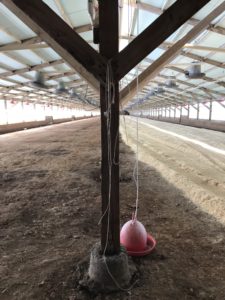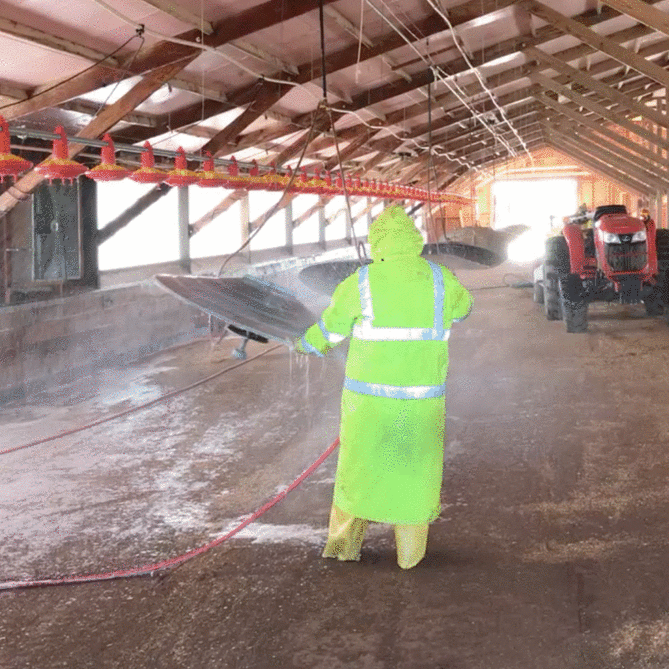Ante Biotics: Before We Tackle Antibiotics, Let's Talk About Biofilm
Everybody’s heard of antibiotics.
But if you’re like most people (and let’s face it: is any one of us really that special?) then you’ve probably never heard of biofilm.
It might sound like something you could only find in the infirmary aboard a starship in your favorite sci fi movie, but the truth is that biofilm is all around us, and it plays an enormous role in our health—and in the food we produce at Diestel Family Ranch, as well as what we eat. (That’s the royal we—you and me!)
Alright, so what is it?
Biofilm is, well, a kind of “film” that forms on surfaces where microorganisms are present (namely, everywhere). Think of it like an invisible sheet of plastic wrap that’s wound around almost everything you see.
Beneath that biofilm (and within it, and on top of it) there are microorganisms, all carrying on with their daily lives. Some of them are good, some of them are not so good, and some of them are very, very bad—including pathogens that can cause any number of health problems.
No big deal, right? This is 2020! We’ve got all sorts of products designed to kill harmful bacteria.

The answer is more complicated than that for a couple of reasons:
Biofilm makes it incredibly difficult to kill microorganisms. Imagine taking that plastic wrap we pulled out of the drawer earlier and coating your kitchen counter with it before trying to wipe it clean. Sure, you’ll wipe away whatever’s on top of the plastic wrap, but you won’t touch what’s beneath it.
Biofilm works the same way, protecting the microorganisms beneath it from the world outside (and, more to our point, standard chemical cleaners).
Microorganisms that aren’t completely eliminated build resistances. Some cleaners may kill what’s on the biofilm’s surface. Some might even break through any thin or weak layers in the biofilm, killing what’s beneath. But the vast majority of microorganisms will survive, and they’ll adapt and evolve to better survive the next attack.
If you’ve heard of antibiotic resistances and superbugs (and no, not like Ant Man, although we can’t imagine anybody better suited for the role than Paul Rudd), then you’ve heard of biofilms—they’re a leading contributor.
“Hey, wait a minute,” you might be saying. “It says on the bottle that my household cleaner is proven effective in killing 99.9% of harmful germs and bacteria! Surely that’s beating the biofilm.”
Nope.
Most disinfectants’ effectiveness is validated in sterile environments that are engineered not to have any biofilm. If biofilm were present, those disinfectants would be far less effective. (Not to mention, their advertising campaigns would be a lot less inspiring; who wants to buy a household cleaner that’s proven to kill some of the bacteria some of the time?)
Alright, so there’s this thing called biofilm on almost every surface in sight, and it makes it incredibly difficult to know for certain whether we ever got a surface clean. Then how do we keep our families, food, and… help me out—what’s an f-word that means “homes”—clean?
The answer is simple—literally and figuratively: Probiotics.
Biofilm is a natural compound, and probiotics—in effect, beneficial microorganisms—have proven incredibly effective at reducing the prevalence of biofilm, as well as eliminating the microorganisms that make it.
Don’t get us wrong: antibiotics have their place in the world, and it’s incredibly important that they be accessible for those who need them.
At the same time, we believe that if a farm needs to rely on antibiotics to produce healthy animals, then there’s a problem further up the supply and production chain that, if solved, could eliminate the need for antibiotics altogether.
All of our products are produced without the use of antibiotics—ever—and it’s thanks in large part to three key steps that we take around the farm:
- The Water: When we say biofilm can build up anywhere, we mean anywhere—including in the pipes that deliver water throughout the farm. That’s why we use healthy probiotics cleaner in the water, helping not only to eliminate biofilm that might otherwise form within, but to create a probiotic barrier film that keeps water clean and pathogen or "bad guy" bacteria free—improving the health and lives of our turkeys (and you!) in the process.
- The Barns: Livestock veterinarians are big on the practice of cleaning and disinfection, helping to eliminate potential pathogens in a space before the animals are placed there. But when you think about it, that cleaning and disinfection only helps to guarantee a space is clean at the moment it’s disinfected; what about the next day (or the day after that) as microorganisms grow back? In all of our barns, we use a probiotic mist to keep pathogenic bacteria at bay, taking cues from nature and what we learned in developing our GAP Step 5 process.
- The Cleaning: Obviously, a clean setting is only clean as long as new organisms and contaminants aren’t being carried in from the outside world. Wherever we have a wash system set up—whether it’s for trucks entering or leaving the farm, or simply for boots as we go from one barn to another—Diestel Family Ranch uses a simple, organic probiotic-based soap that performs as well or better than its conventional counterparts.

Combined, the three steps above help to reduce the occurrence and buildup of biofilms across our operation, which means a cleaner environment, happier, healthier animals, and a clean and delicious product for you and your family. Win after win after mouthwatering win.
But if it’s such a big deal—and if the solution seems so simple—why haven’t you heard more about it?
It’s an enormous shift in paradigm for an industry that’s been treating symptoms rather than root causes for generations (and for a whole lot of companies who make their money selling products to treat those symptoms).
But we’ve always believed that if there’s a right choice, we’ll make it—no compromises, no question—and the choice to use probiotics to combat biofilms falls squarely in that category.